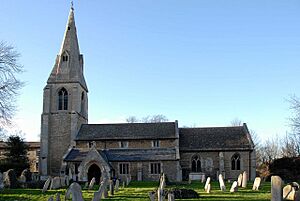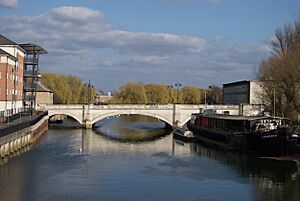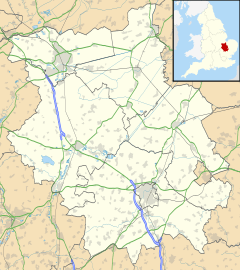Fletton facts for kids
Quick facts for kids Fletton |
|
|---|---|
 St Margaret's Church, Old Fletton |
|
| Unitary authority |
|
| Ceremonial county | |
| Region | |
| Country | England |
| Sovereign state | United Kingdom |
| Post town | PETERBOROUGH |
| Postcode district | PE2 |
| Dialling code | 01733 |
| EU Parliament | East of England |
Fletton is an area in the city of Peterborough, England. It is located south of the River Nene. Fletton is well-known for its large brick factories. These factories make special bricks called "Fletton bricks."
Contents
How Fletton is Governed
Fletton is south of the River Nene. Long ago, it was part of Huntingdonshire. This was a different county than the Soke of Peterborough, which was in Northamptonshire.
Fletton was once split into two parts. Old Fletton had its own local council. New Fletton was managed as part of Peterborough. The boundary between them was at Fletton Spring.
In 1965, Huntingdonshire and the Soke of Peterborough joined together. In 1974, Fletton became part of the Peterborough area. Today, Peterborough is a special type of local authority called a unitary authority. This means it manages its own services. Fletton is part of the North West Cambridgeshire area for national elections.
Fletton's Main Industries

The ground in Fletton has a special type of clay called Oxford clay. This clay is easy to dig up. Because of this, many large brick factories were built here.
The Famous Fletton Bricks
The area gave its name to the Fletton Brick Company in the 1800s. This company later became the London Brick Company. Today, it is owned by Forterra plc. London Brick made many of the country's famous buildings using "Fletton bricks."
Italian Community in Fletton
In the 1950s, the brick factories needed many workers. Not enough local people were available. So, many Italians came to Fletton for work. They came from southern Italy, especially from Apulia and Campania.
By 1960, about 3,000 Italian men worked for London Brick. Soon after, about 2,000 Italian women also arrived. Some worked in the factories. Others worked in clothing, food, or healthcare. Because of this, Fletton has a large Italian community today. The Italian Community Association manages a building called the Fleet complex. This building helps support the Italian community in Peterborough.
Other Local Businesses
Other important companies also provided jobs in Fletton. Perkins Engines made diesel engines. Bennie Lifts, later called Kone, made lifts. Elliot Medway, a company that made mobile classrooms, was also in Fletton. Its site was removed in 2008 to make way for new buildings.
Places to Visit and Use
Churches and Cemeteries
The Church of England parish church in Fletton is called Saint Margaret of Antioch. It is a very old building. St Margaret's Church is a Grade I listed building, meaning it is very important.
Fletton cemetery is also on Fletton Avenue. It opened for burials in 1893. There was also an Italian Catholic church called Saint Anthony (San Antonio). It was run by the Scalabrini Fathers.
Schools and Nature
Old Fletton County Primary School is in the area. Older students go to nearby Stanground Academy and Nene Park Academy.
Fletton Spring is a natural spring. It starts in the west of the area. It goes underground for a bit, then comes out near Fletton Fields. Finally, it joins with Stanground Lode in the east.
Sports and Development
Peterborough United F.C. is a football team. They play their games at the London Road Stadium in Fletton.
The Territorial Army has a centre on London Road. This is where the 158 (Royal Anglian) Transport Regiment (Volunteers) is based.
The Fletton Quays development is a new project. It is building on old land and empty buildings. This area is between the river and the railway line.
Famous People from Fletton
- Peter Peckard (1718–1797) was a church leader. He was also a Vice-Chancellor of Cambridge University. He worked to end slavery. He was a rector at St Margaret's Church.
- Alfred Nicholson Leeds (1847–1917) found many dinosaur and ancient animal fossils in the Fletton brick pits.
- Frederick Wallace Edwards (1888–1940) was born in Fletton. He was an entomologist, which means he studied insects.
- The author L. P. Hartley (1895–1972) spent his childhood at Fletton Tower.


